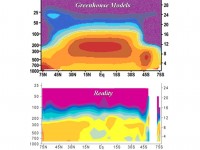By James Lewis
James Hansen, NASA’s True Believer in the global warming credo, has just been quoted by the Globe & Mail of Canada as follows: “Prof. Hansen and his colleagues argue that rapidly melting ice caps in Antarctica and Greenland could cause oceans to swell several metres by 2100 - or maybe even as much as 25 metres, which is how much higher the oceans sat about three million years ago.” “If we follow ‘business-as-usual’ growth of greenhouse gas emissions… I think that we will lock in a guaranteed sea-level rise of several meters, which, frankly, means that all hell is going to break loose.”
So you have a choice. You can either (a) hop in your car and head for the hills, or (b) consider the very real possibility that Dr. James Hansen has jumped the shark, and is rocketing upward fast enough to achieve orbital velocity. I personally think he has slipped the surly bonds of earth, as the poet says. NASA’s Prophet of Doom is up, up and away, with a beautiful vrroom.
Dr. Hansen has gone further out on a limb, and has now issued a challenge to our presidential candidates. He wants all the 2008 candidates to sign a Declaration of Stewardship for the Earth and all Creation.
So does Dr. Hansen really expect billions of human beings to stop wanting things? Imagine all those cars screeching to a halt. Imagine NASA crumbling, never to launch another space probe. That’s “economically sound” according to our hero, because it would lower carbon emissions. This is not sound scientific thinking. It does not reflect well on NASA. Maybe Dr. Hansen should just become Al Gore’s speech writer, rather than occupying a tax-paid position in government science. Because it’s less than honest to use the credibility of science in pursuit of some personal obsession.
See whole story here.
Also read in NEWSBUSTERS how Hansen has been harshly criticized by a leading IPCC author about moving from scientific discourse towards advocacy.
By Christopher Monckton, 3rd Viscount of Brenchley on SPPI
“The fingerprint of anthropogenic greenhouse warming predicted by computer models is absent from real-world, observed trends in atmospheric temperature change...”

THE FACT of warming tells us nothing of the cause. Yet the scientific “consensus” is that, though the rapid climatic warming from 1906 to 1940 was a natural recovery from the historically low temperatures of the Little Ice Age, it is we who are chiefly to blame for the equally rapid warming from 1975 to the present.
Since some climatologists challenge this consensus, can we settle the debate by predicting with models and then detecting by observation a characteristic “signature” in the climate data that allows us definitively to distinguish between anthropogenic and natural warming of the Earth’s atmosphere? This paper answers that key question.
Read more here. See more on SPPI here.
By Patrick Moore, Special to the Vancouver Sun
Despite the anti-forestry scare tactics of celebrity movies, trees are the most powerful concentrators of carbon on Earth Dr. Patrick Moore is a co-founder of Greenpeace and chairman and chief scientist of Greenspirit Strategies Ltd. in Vancouver.
It seems like there’s a new doomsday documentary every month. But seldom does one receive the coverage that Hollywood activist Leonardo DiCaprio’s latest climate-change rant, The 11th Hour, is getting.Here’s a key piece of information DiCaprio, collaborator and long-time activist Tzeporah Berman and the leadership of my old organization Greenpeace are ignoring when it comes to forests and carbon: For British Columbians, living among the largest area of temperate rainforest in the world, managing our forests will be a key to reducing greenhouse gases.
As a lifelong environmentalist, I say trees can solve many of the world’s sustainability challenges. Forestry is the most sustainable of all the primary industries that provide us with energy and materials. Rather than cutting fewer trees and using less wood, DiCaprio and Berman ought to promote the growth of more trees and the use of more wood. Trees are the most powerful concentrators of carbon on Earth. Through photosynthesis, they absorb CO2 from the atmosphere and store it in their wood, which is nearly 50 per cent carbon by weight. Trees contain about 250 kilograms of carbon per cubic metre. Read the story here.


